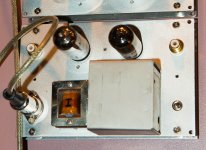I was thinking about making a phono preamp without caps in RIAA circuit.
Will this topology be good?
If so, how to calculate the inductors and resistor values? (knowing the preceding stage output impedance and following stage grid resistor value).
Will this topology be good?
An externally hosted image should be here but it was not working when we last tested it.
If so, how to calculate the inductors and resistor values? (knowing the preceding stage output impedance and following stage grid resistor value).
Those who wish to use an unusual topology should understand it enough to know why they want to use it instead of the more common better topologies. As a side effect of this, they will know how to calculate it.
There are good reasons why people generally use C and R for RIAA networks.
There are good reasons why people generally use C and R for RIAA networks.
I am fully aware of all limitations and difficulties related with this type of RIAA correction. But I'm willing to try it anyway, just for fun.
To be honest, I don't "understand" why I want to use it. But I also don't understand why I'm using turntables and single ended triode amplifiers in 2015 when there's class D amplification and high end digital audio equipment all around . From what I know, there ARE some commercial RIAA preamps using L filters, so there are some people who might be preferring them.
. From what I know, there ARE some commercial RIAA preamps using L filters, so there are some people who might be preferring them.
To be honest, I don't "understand" why I want to use it. But I also don't understand why I'm using turntables and single ended triode amplifiers in 2015 when there's class D amplification and high end digital audio equipment all around
Does "courage" improve audio reproduction?kaputt said:The good reasons for building phono correction networks from rc networks is that it requires little thought, little space, little money and little courage.
It could still be better than an LR network.The sound quality you get out of network copied from the RCA manual is the same: little.
"Nice" in what sense? More hum pickup, more expensive, more distortion, lower Q (so requiring circuit compensation) - all 'nice' features to have in a circuit.Pulatom said:I got bored of making them and LR seems a nice alternative
"Nice" in what sense? More hum pickup, more expensive, more distortion, lower Q (so requiring circuit compensation) - all 'nice' features to have in a circuit.
Let's be fair- one could easily argue that using a tube amp is similarly crazy, yet you and I both do. Why? It's entertaining to use a (now) uncommon technology, and with proper design and construction, we get performance good enough to be "hi fi."
Now, if one claims that an LR preamp will outperform a competent RC circuit, I would want to see some good data backing up that remarkable claim (or an analogous claim about a tube amplifier outperforming a competent solid state design).
True, but I suspect that Pulatom does not yet realise just how much "fun" he is letting himself in for. For a start, his first diagram omits the resistance and capacitance of the inductors. Of course all components have parasitic impedances, but for C and R at audio frequencies these can usually be ignored. For L they must be included in the circuit design.
As I've said before, I'm aware that it won't be a technically perfect circuit.
I treat audio DIY'ing more like fun or even art than rocket science. I think it shouldn't be treated so seriously (except safety precautions, that is). If a circuit works that's great (I don't care about numbers, it just have to sound pleasantly for my ears), if it blows or sounds shitty, well, at least I've learned something new from it.
That's just wonderful, especially combined with a worn scratchy Roy Orbison's LP and candlelight (or fireplace).
Vinyl is also a not-so-perfect medium and clearly worse than, let's say, 192/32 digital audio (in terms of noise, frequency response, dynamic range etc).
I treat audio DIY'ing more like fun or even art than rocket science. I think it shouldn't be treated so seriously (except safety precautions, that is). If a circuit works that's great (I don't care about numbers, it just have to sound pleasantly for my ears), if it blows or sounds shitty, well, at least I've learned something new from it.
"Nice" in what sense? More hum pickup, more expensive, more distortion, lower Q (so requiring circuit compensation) - all 'nice' features to have in a circuit.
That's just wonderful, especially combined with a worn scratchy Roy Orbison's LP and candlelight (or fireplace).
Vinyl is also a not-so-perfect medium and clearly worse than, let's say, 192/32 digital audio (in terms of noise, frequency response, dynamic range etc).
"Nice" in what sense? More hum pickup, more expensive, more distortion, lower Q (so requiring circuit compensation) - all 'nice' features to have in a circuit.
How does "more expensive" influence sound reproduction?
How does "more expensive" influence sound reproduction?
It often (usually?) influences one's preconceptions if one uses evaluation methods involving peeking, rather than ears only.
How does "more expensive" influence sound reproduction?
It obviously helps if one uses better quality components or materials, but only up to a certain point...
It seems obvious to some, but the facts do not always agree. For most components in most circuits, ordinary components are sufficient. The exception is wound components, where good ones cost much more. This is why most people seek to minimise the number of wound components.Pulatom said:It obviously helps if one uses better quality components or materials
- Status
- This old topic is closed. If you want to reopen this topic, contact a moderator using the "Report Post" button.
- Home
- Source & Line
- Analogue Source
- Calculating inductor based passive RIAA
